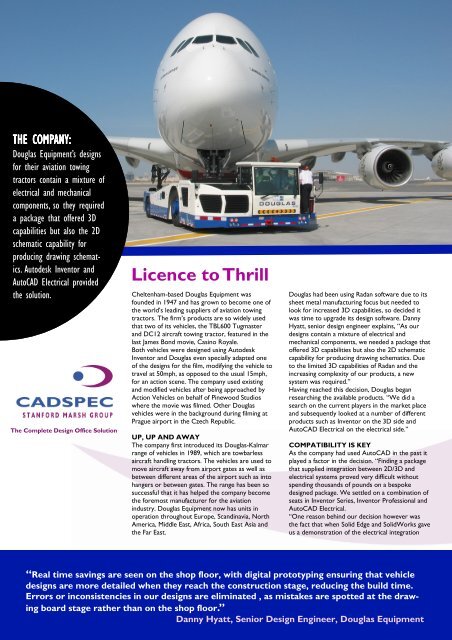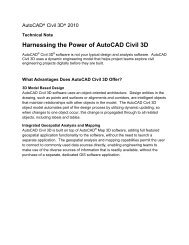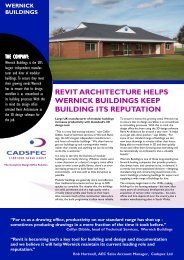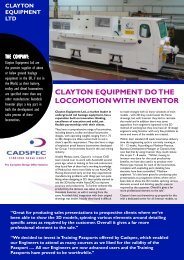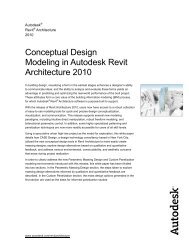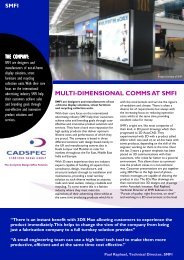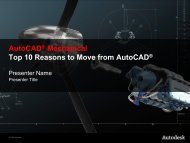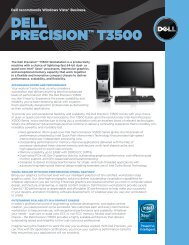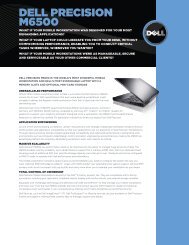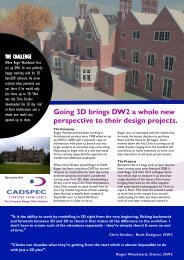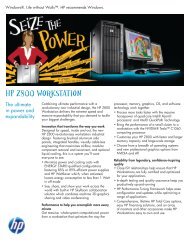Douglas Equipment Casestudy (PDF 1264 Kb) - Cadspec
Douglas Equipment Casestudy (PDF 1264 Kb) - Cadspec
Douglas Equipment Casestudy (PDF 1264 Kb) - Cadspec
You also want an ePaper? Increase the reach of your titles
YUMPU automatically turns print PDFs into web optimized ePapers that Google loves.
THE COMPANY:<br />
<strong>Douglas</strong> <strong>Equipment</strong>’s designs<br />
for their aviation towing<br />
tractors contain a mixture of<br />
electrical and mechanical<br />
components, so they required<br />
a package that offered 3D<br />
capabilities but also the 2D<br />
schematic capability for<br />
producing drawing schematics.<br />
Autodesk Inventor and<br />
AutoCAD Electrical provided<br />
the solution.<br />
The Complete Design Office Solution<br />
Licence to Thrill<br />
Cheltenham-based <strong>Douglas</strong> <strong>Equipment</strong> was<br />
founded in 1947 and has grown to become one of<br />
the world’s leading suppliers of aviation towing<br />
tractors. The firm’s products are so widely used<br />
that two of its vehicles, the TBL600 Tugmaster<br />
and DC12 aircraft towing tractor, featured in the<br />
last James Bond movie, Casino Royale.<br />
Both vehicles were designed using Autodesk<br />
Inventor and <strong>Douglas</strong> even specially adapted one<br />
of the designs for the film, modifying the vehicle to<br />
travel at 50mph, as opposed to the usual 15mph,<br />
for an action scene. The company used existing<br />
and modified vehicles after being approached by<br />
Action Vehicles on behalf of Pinewood Studios<br />
where the movie was filmed. Other <strong>Douglas</strong><br />
vehicles were in the background during filming at<br />
Prague airport in the Czech Republic.<br />
UP, UP AND AWAY<br />
The company first introduced its <strong>Douglas</strong>-Kalmar<br />
range of vehicles in 1989, which are towbarless<br />
aircraft handling tractors. The vehicles are used to<br />
move aircraft away from airport gates as well as<br />
between different areas of the airport such as into<br />
hangers or between gates. The range has been so<br />
successful that it has helped the company become<br />
the foremost manufacturer for the aviation<br />
industry. <strong>Douglas</strong> <strong>Equipment</strong> now has units in<br />
operation throughout Europe, Scandinavia, North<br />
America, Middle East, Africa, South East Asia and<br />
the Far East.<br />
<strong>Douglas</strong> had been using Radan software due to its<br />
sheet metal manufacturing focus but needed to<br />
look for increased 3D capabilities, so decided it<br />
was time to upgrade its design software. Danny<br />
Hyatt, senior design engineer explains, “As our<br />
designs contain a mixture of electrical and<br />
mechanical components, we needed a package that<br />
offered 3D capabilities but also the 2D schematic<br />
capability for producing drawing schematics. Due<br />
to the limited 3D capabilities of Radan and the<br />
increasing complexity of our products, a new<br />
system was required.”<br />
Having reached this decision, <strong>Douglas</strong> began<br />
researching the available products. “We did a<br />
search on the current players in the market place<br />
and subsequently looked at a number of different<br />
products such as Inventor on the 3D side and<br />
AutoCAD Electrical on the electrical side.”<br />
COMPATIBILITY IS KEY<br />
As the company had used AutoCAD in the past it<br />
played a factor in the decision. “Finding a package<br />
that supplied integration between 2D/3D and<br />
electrical systems proved very difficult without<br />
spending thousands of pounds on a bespoke<br />
designed package. We settled on a combination of<br />
seats in Inventor Series, Inventor Professional and<br />
AutoCAD Electrical.<br />
“One reason behind our decision however was<br />
the fact that when Solid Edge and SolidWorks gave<br />
us a demonstration of the electrical integration<br />
“Real time savings are seen on the shop floor, with digital prototyping ensuring that vehicle<br />
designs are more detailed when they reach the construction stage, reducing the build time.<br />
Errors or inconsistencies in our designs are eliminated , as mistakes are spotted at the drawing<br />
board stage rather than on the shop floor.”<br />
Danny Hyatt, Senior Design Engineer, <strong>Douglas</strong> <strong>Equipment</strong>
THE BENEFIT:<br />
Digital Prototyping has<br />
provided not only real<br />
time savings on the<br />
shop floor but also<br />
cost savings as it<br />
eliminates any errors<br />
spotted at the<br />
drawing board stage.<br />
For further information<br />
Visit us on the web at:<br />
www.cadspec.co.uk/inventor<br />
offered by their products, both were based on<br />
AutoCAD. Were we to have gone with any of the<br />
other products we were contemplating we would<br />
also have had to purchase a license of AutoCAD<br />
to carry out the electrical side of the designs, so<br />
we decided it made sense to go with Autodesk<br />
and buy everything together.” adds Hyatt.<br />
Another important factor was that Autodesk<br />
Inventor also offered digital prototyping<br />
capabilities, which would allow the firm to<br />
produce more accurate designs by testing and<br />
analysing performance at the design stage. This<br />
reduces the chance of costly mistakes going<br />
un-noticed until the build stage, when they can<br />
become costly to rectify.<br />
<strong>Douglas</strong> worked with Autodesk reseller <strong>Cadspec</strong><br />
for the implementation of the software, and also<br />
selected product training for Inventor from the<br />
firm. Hyatt says of the relationship with <strong>Cadspec</strong>,<br />
“They are always there if we have any questions<br />
or problems, to the extent that one of their guys<br />
lives locally to our offices and if we have any<br />
trouble he will call in on his way into work to fix<br />
it. In this respect they have been able to address<br />
any issues we have straight away.”<br />
Wayne Kite of <strong>Cadspec</strong> explains their role in the<br />
implementation process. “We have been working<br />
with <strong>Douglas</strong> since their decision to upgrade two<br />
years ago and we have a particularly good<br />
relationship with them. Danny Hyatt knew the<br />
system he wanted and how it needed to work, so<br />
we dedicated time to them to achieve this.”<br />
In terms of the training Hyatt says that although<br />
Inventor and Electrical are easy to pick up, “as<br />
with any new software there is a learning curve,<br />
but we have found the new system fairly straightforward<br />
and have been very pleased with<br />
<strong>Cadspec</strong>’s training. In addition to the Inventor<br />
training we received through <strong>Cadspec</strong>, we also<br />
invested in AutoCAD Electrical training with<br />
Aceri.”<br />
TUGS AWAY<br />
Having completed the implementation process<br />
<strong>Douglas</strong> is now using Inventor and AutoCAD<br />
Electrical to design all of its new products, the<br />
first of which was a new electric vehicle of the<br />
Japanese Ministry of Defence. “The vehicle was<br />
designed completely using Inventor. We were able<br />
to do a complete design (including full FEA analysis<br />
using ANSYS design space linked to the Inventor<br />
model) and BOM using the software and even<br />
went as far as producing nut/bolt lists for the<br />
customer. All of the electrical systems were designed<br />
in 3D, harnesses, junction box layouts etc<br />
and schematics completed in AutoCAD Electrical.<br />
This vehicle in particular was very critical on space<br />
and weight. Inventor helped us to refine the<br />
design to achieve the customer’s specification,”<br />
explains Hyatt.<br />
<strong>Douglas</strong> is also in the process of transferring the<br />
majority of its legacy data to Inventor using<br />
Autodesk Productstream. “We are now<br />
converting our entire drawing database which<br />
consists of multitude of different drawing<br />
formats; scanned printed (TIFF) documents, DWF,<br />
DWG, DXF and Radan drawings into one<br />
consolidated drawing database of data to be held<br />
in the Vault (via Productstream). RADAN 3D<br />
models are being converted into true Inventor<br />
models but in order to use the data immediately<br />
we are using SAT data directly mixed with true<br />
Inventor data in 3D,” explains Mr Hyatt.<br />
Again <strong>Douglas</strong> worked with <strong>Cadspec</strong> for this<br />
aspect of the process. “In order to achieve the<br />
required results, we had to customise Productstream<br />
to fit with <strong>Douglas</strong>’ system,” explains Kite.<br />
So far <strong>Douglas</strong> has completed the design of five<br />
entire vehicles in Inventor and is in the process of<br />
transferring a further six designs into Inventor.<br />
The remaining designs will stay as DWF files in a<br />
database of drawings.<br />
TIME SAVINGS<br />
Having got to grips with the software Mr Hyatt<br />
says that the main benefit to <strong>Douglas</strong> has been the<br />
fact that the company is now able to develop a<br />
more complete design process. This has speeded<br />
up the design to build cycle as Mr Hyatt explains.<br />
“We are spending more time on the initial design<br />
process as our plans are a lot more detailed. Real<br />
time savings, however, are seen on the shop floor,<br />
with digital prototyping ensuring that vehicle<br />
designs are more detailed when they reach the<br />
construction stage, reducing the build time. Errors<br />
or inconsistencies in our designs are eliminated, as<br />
mistakes are spotted at the drawing board stage<br />
rather than on the shop floor.”<br />
The new <strong>Douglas</strong> designs have been a big hit with<br />
positive feedback from new clients and those<br />
involved in the construction of the vehicles. “Our<br />
guys on the shop floor have been particularly<br />
impressed by the level of detail in the new<br />
designs,” adds Mr Hyatt.<br />
<strong>Douglas</strong> is also able to produce build manuals for<br />
its products, available to manufacturers on the<br />
shop floor as well as to technical customers,<br />
providing detailed information on the products.<br />
READY FOR TAKE OFF<br />
Looking forward, Danny Hyatt says that the<br />
company would like to tailor the software to<br />
better suit its specific needs. “Currently Inventor<br />
is satisfying around 80% of our needs,” he says,<br />
“and with specific tailoring it should be able to<br />
meet the remaining 20% of our requirements. And<br />
we may at some point invest in 3ds Max Design to<br />
offer enhanced 3D visualisation capabilities.”<br />
Head Office Worcester: Offices also at: Telephone: 01905 458000<br />
Haycroft Works, Buckholt Drive Neath: 01792 323184 email: sales@cadspec.co.uk<br />
Warndon Business Parks Bristol: 0844 847 9795 www.cadspec.co.uk<br />
Worcester, WR4 9ND Derby: 0844 875 0432<br />
2009<br />
The Complete Design Office Solution<br />
Autodesk, AutoCAD and Inventor are registered trademarks of Autodesk Inc., in the USA and/or other countries All other brand names, product names or trademarks belong to their respective owners. © 2008 <strong>Cadspec</strong> Ltd.<br />
All rights reserved.


